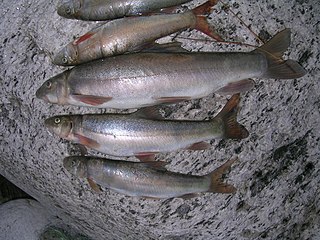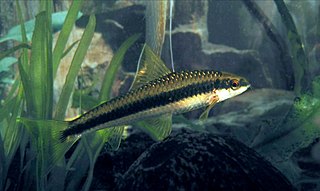
The Cyprinidae are the family of freshwater fish, collectively called cyprinids, that includes the carps, the true minnows, and their relatives. Also commonly called the "carp family", or "minnow family", Cyprinidae is the largest and most diverse fish family and the largest vertebrate animal family in general, with about 3,000 species of which only 1,270 remain extant, divided into about 370 genera. They range from about 12 mm to the 3-m Catlocarpio siamensis. The family belongs to the ostariophysian order Cypriniformes, of whose genera and species the cyprinids make up more than two-thirds. The family name is derived from the Ancient Greek kyprînos.

Cypriniformes is an order of ray-finned fish, including the carps, minnows, loaches, and relatives. This order contains 11-12, although some authorities have designated as many as 23, families over 400 genera, and more than 4,250 species, with new species being described every few months or so, and new genera being recognized frequently. They are most diverse in southeastern Asia, and are entirely absent from Australia and South America. At 112 years old, the longest-lived cypriniform fish documented is the bigmouth buffalo.

Phoxinus is a genus of freshwater fish in the family Leuciscidae of order Cypriniformes, and the only members of the subfamily Phoxininae, or Eurasian minnows. The type species is Phoxinus phoxinus. The other species in this genus are also commonly known as minnows. The name "minnow" was what early English fisherman used to describe "small and insignificant". The genus Phoxinus is found throughout Eurasia, and includes 21 known species. Previously, members of the North American genus Chrosomus were also believed to form part of this genus.

Schizothorax is a genus of cyprinid fish found in southern and western China, through northern South Asia (Himalaya) and Central Asia, to Iran, with a single species, S. prophylax, in Turkey. They are primarily found in highland rivers, streams and lakes, although a few species occur in lower-lying locations, like Lake Balkhash and lakes of the Sistan Basin. Their scientific name means "cloven-breast", from Ancient Greek schízeïn (σχίζειν) "to cleave" and thórax (θώραξ) "breast-plate". The western species are typically referred to as marinkas from their Russian name marinka (маринка), while the eastern species are usually called snowtrout. Although they do resemble trouts in habitus this is merely due to convergent evolution and they are by no means closely related apart from both being Teleostei: Cyprinids are in the teleost superorder Ostariophysi, while trouts are in the superorder Protacanthopterygii. Their ancestors must thus have diverged as early as the Triassic, more than 200 million years ago.
Sinocyclocheilus is a genus of freshwater fish in the family Cyprinidae endemic to China, where only found in Guangxi, Guizhou and Yunnan. Almost all of its species live in or around caves and most of these have adaptions typical of cavefish such as a lack of scales, lack of pigmentation and reduced eyes. Several species have an unusual hunchbacked appearance and some of the cave-dwellers have a "horn" on the back, the function of which is unclear. In contrast, the Sinocyclocheilus species that live aboveground, as well as a few found underground, show no clear cavefish adaptions. They are relatively small fish reaching up to 23 cm (9.1 in) in length. The individual species have small ranges and populations, leading to the status of most of the evaluated species as threatened. Many species populations in the genus have yet to be evaluated by the IUCN.

Garra is a genus of fish in the family Cyprinidae. These fish are one example of the "log suckers", sucker-mouthed barbs and other cyprinids commonly kept in aquaria to keep down algae. The doctor fish of Anatolia and the Middle East belongs in this genus. The majority of the more than 140 species of garras are native to Asia, but about one-fifth of the species are from Africa.

The bitterling-like cyprinids form the cyprinid subfamily Acheilognathinae. This subfamily contains four genera, although the Khanka spiny bitterling is often placed in Acheilognathus, and at least 71 described species to date. Over half of the species are in the genus Acheilognathus.

Labeoninae is a doubtfully distinct subfamily of ray-finned fishes in the family Cyprinidae of order Cypriniformes. They inhabit fresh water and the largest species richness is in the region around southern China, but there are also species elsewhere in Asia, and some members of Garra and Labeo are from Africa. They are a generally very apomorphic group, perhaps the most "advanced" of the Cyprinidae. A common name for these fishes is labeonins or labeoins.
Barbinae are a subfamily of fish included in the family Cyprinidae. The taxonomy for this group has not been entirely worked out as some genera historically considered within it are still considered incertae sedis with respect to being a member of the family, and may be included here, while others may be moved to other subfamilies.

Autosticha is a genus of gelechioid moths. It belongs to the subfamily Autostichinae, which is either placed in the concealer moth family (Oecophoridae), or in an expanded Autostichidae. It is the type genus of its subfamily. Originally, this genus was named Automola, but this name properly refers to a fly genus in family Richardiidae.
Saurogobio is a genus of cyprinid fish found in eastern Asia.

The danionins are a group of small minnow-type fish belonging to the family Cyprinidae. Members of this group are mostly in the genera Danio, Devario and Rasbora. They are primarily native to the fresh waters of South and Southeast Asia, with fewer species in Africa. Many species are brightly coloured and are available as aquarium fish worldwide. Danio species tend to have horizontal stripes, rows of spots, or vertical bars, and often have long barbels. Devario species tend to have vertical or horizontal bars, and short rudimentary barbels, if barbels are present at all. All danionins are egg scatterers and breed in the rainy season in the wild. They are carnivores living on insects and small crustaceans.

Gobioninae is a monophyletic subfamily of Eurasian cyprinid fishes. A species-rich subfamily, it is divided into five tribes: Gobionini, Pseudogobionini, Hemibarbini, Coreiini, and Sarcocheilichthyini.
Setihercostomus is a genus of flies in the family Dolichopodidae, known from China, Taiwan, Russia and Tanzania.

The Cyprininae are one of at least 11 subfamilies of cyprinid fish. It contains three genera in its strictest definition but many more are included depending on which authority is defining it, especially if the Labeobarbinae is not considered to be a valid grouping.
Fang Fang Kullander, née Fang Fang, was a Swedish-Chinese ichthyologist.

Alburninae is a small subfamily of the carp and minnow family of ray-finned fish, the Cyprinidae. The genera in this subfamily were previously considered to be part of the Leuciscinae,but if the three Alburninae genera are included in that subfamily, it is paraphyletic. The Alburninae are still a contentious group and some authorities consider it to consist of two distinct clades, making it biphyletic.

Squaliobarbinae is a small subfamily of the carp and minnow family, Cyprinidae, which consists of three monotypic genera which have their natural distributions in eastern Asia. Two species, the grass carp and the black carp, have been introduced to other parts of the world for weed control and aquaculture. They are large cyprinids which are characterised by an enlarged subtemporal fossa, the palate articulating with the supraethmoid, an enlarged intercalar bone in the cranial vault and a divided levator posterior muscle.

Opsariichthys evolans is a species of cyprinid fish. It inhabits southeastern China and Taiwan. It has a maximum male length of 9.0 centimetres (3.5 in) and a maximum female length of 7.0 centimetres (2.8 in).
Opsariichthys kaopingensis is a species of cyprinid fish. It is endemic to southern Taiwan and has a maximum standard length of 11.4 centimetres (4.5 in). The specific name kaopingensis refers to its type locality, Kaoping River.














